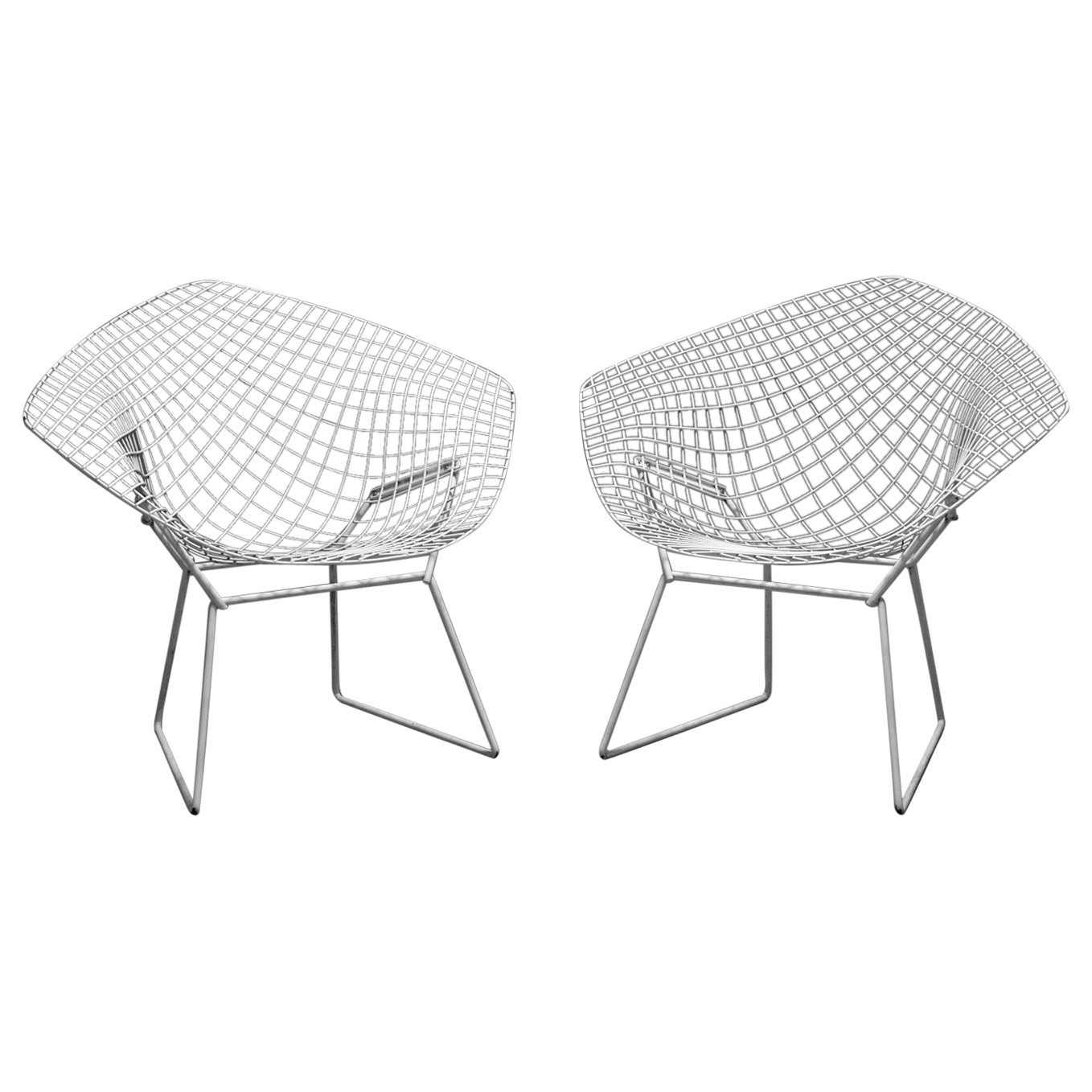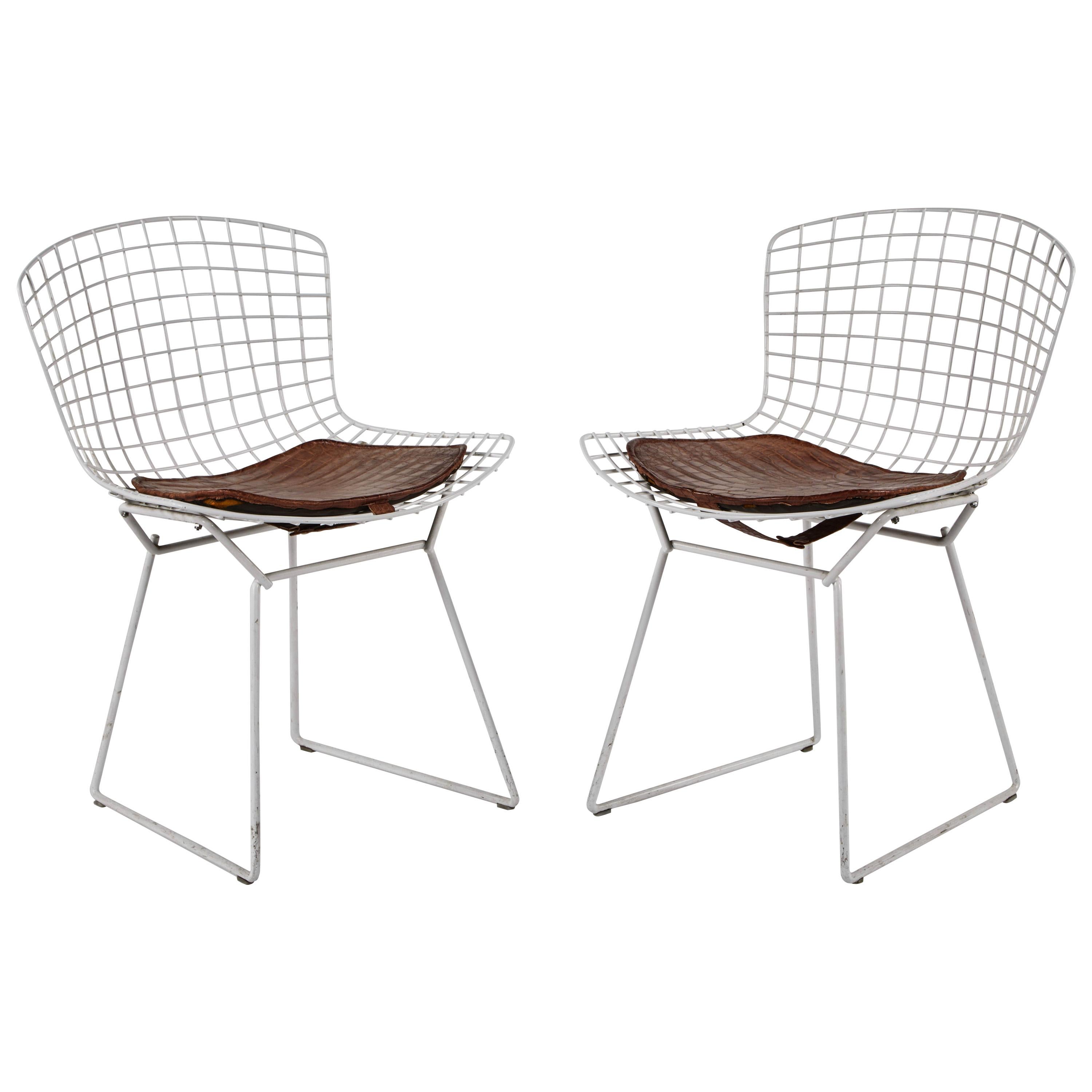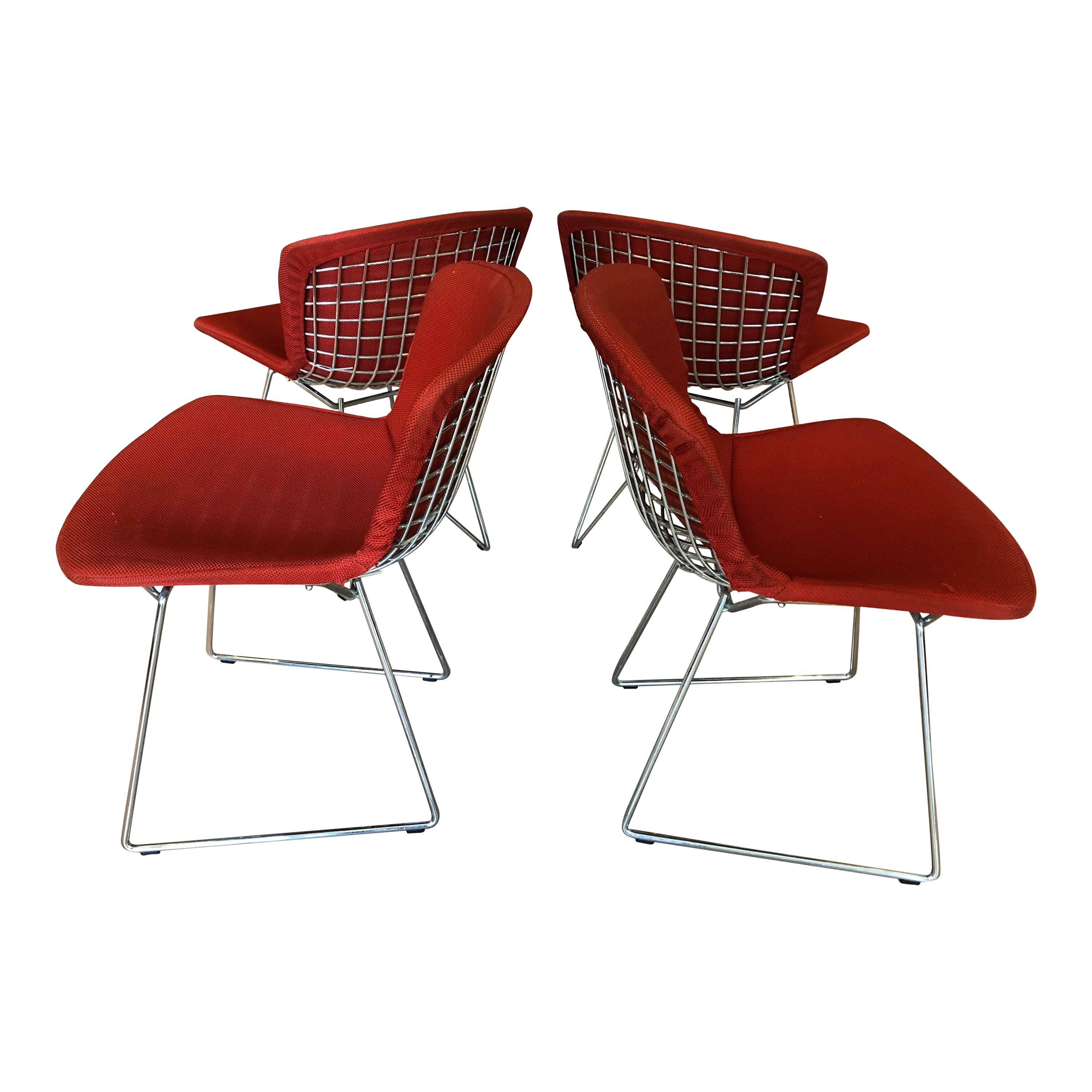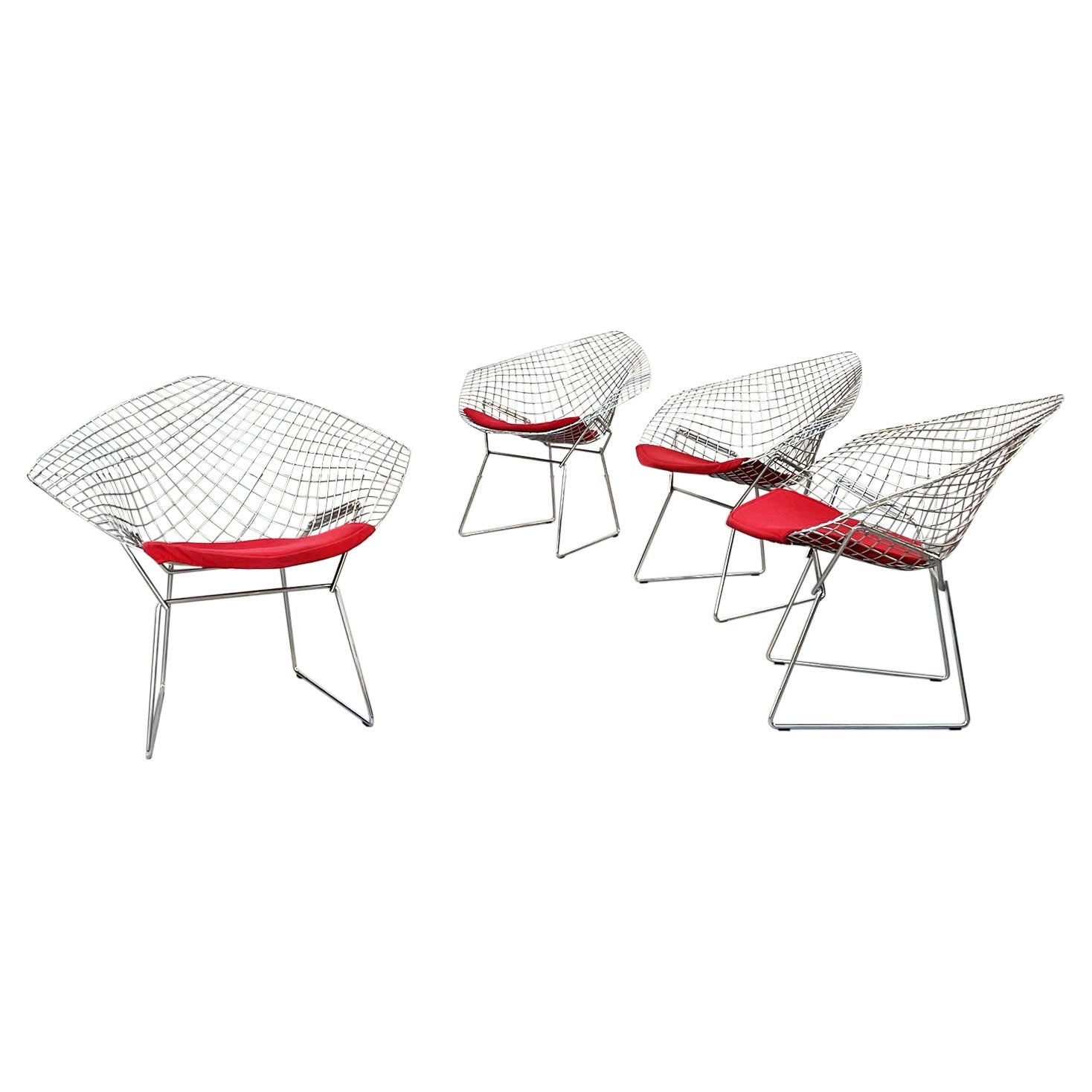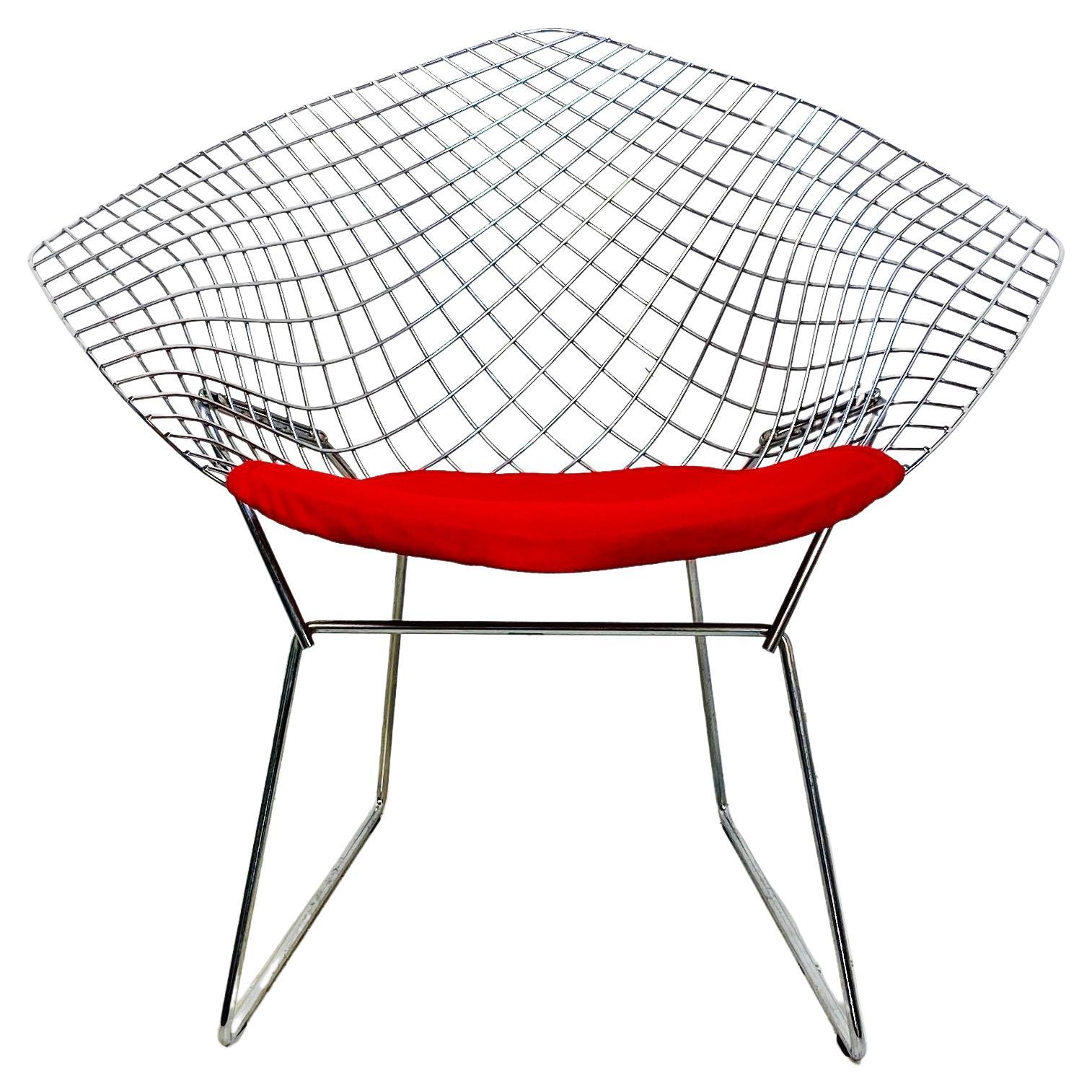Bertoia, Eight White Welded Steel Chairs with Four Red Cushions
About the Item
- Creator:Harry Bertoia (Designer)
- Design:
- Dimensions:Height: 28.75 in (73.03 cm)Width: 21.75 in (55.25 cm)Depth: 19.75 in (50.17 cm)Seat Height: 17.75 in (45.09 cm)
- Sold As:Set of 12
- Style:Mid-Century Modern (Of the Period)
- Materials and Techniques:
- Place of Origin:
- Period:
- Date of Manufacture:1952
- Condition:Wear consistent with age and use. Harry Bertoia's 1950 experiment with bending metal rods into practical art produced a revered collection of seating, including the exquisite Bertoia side chair. Innovative, comfortable, strikingly handsome, very strong & durable + four red cushions.
- Seller Location:Bloomfield Hills, MI
- Reference Number:1stDibs: LU7781233485392
Bertoia Side Chair
When Hans and Florence Knoll invited Italian-American artist Harry Bertoia (1915–78) to move from California to Pennsylvania in 1950 to work with their new design firm, they did not ask him to develop any specific pieces but instead to investigate whatever interested him. That open-ended experimentation led to the 1952 Bertoia Side chair, which was fitted with a fluid metal lattice that gave the seating an ethereal quality. Bertoia considered his collection of chairs created for Knoll Associates to be “mainly made of air, like sculpture,” as he bent steel wire into striking lightweight forms.
While these chairs were innovative in their use of industrial materials, they also had a progressive approach to the ergonomics of seating. Bertoia had previously collaborated with Charles and Ray Eames on molded plywood chairs — what would become the LCW (Lounge Chair Wood) — yet was miffed by the lack of credit for his work. He went on to take a job in engineering for the human body at the Point Loma Naval Electrical Lab in La Jolla, California, during which he created metal sculptures in his spare time. The opportunity from Knoll, another of his former classmates at the famed Cranbrook Academy of Art in Michigan — Bertoia met the Eameses and Knoll and later taught metalworking there — gave him the time and space to devote himself to his own ideas independently. And, as with all Knoll designers, he would get named recognition for his designs.
In a garage in Bally, Pennsylvania, he set up his metal shop and developed ideas for the welded steel grids he would use in his seating. At the time, most chairs were constructed from wood; Bertoia saw the potential for graceful and comfortable designs in the strong material of metal. Along with the Bertoia Side chair, he created the Diamond chair with a diamond pattern in its metalwork and the undulating Asymmetric Chaise (which was too complicated to manufacture until 2005), all with the transparent volume that gives his metal furniture a sense of floating.
Although he would shift to making art rather than furniture, Bertoia still worked on a number of sculptural and architectural designs for the Knoll Planning Unit in the years that followed. Knoll, Inc. has produced the Bertoia Side chair since it was introduced, with its durable materials and optional upholstery or seat covers that can be snapped on and off, making it popular for indoor and outdoor seating.
Harry Bertoia
Sculptor, furniture and jewelry designer, graphic artist and metalsmith, Harry Bertoia was one of the great cross-disciplinarians of 20th-century art and design and a central figure in American modernism. Among furniture aficionados he is known for the wire-lattice Diamond chair (and its variants such as the tall-backed Bird chair) designed for Knoll Inc. and first released in 1952. As an artist, Bertoia is revered for a style that was his alone. Bertoia’s metal sculptures are by turns expressive and austere, powerful and subtle, intimate in scale and monumental. All embody a tension between the intricacy and precision of Bertoia’s forms and the raw strength of his materials: steel, brass, bronze and copper.
Fortune seemed to guide Bertoia’s artistic development. Born in northeastern Italy, Bertoia immigrated to the United States at age 15, joining an older brother in Detroit. He studied drawing and metalworking in the gifted student program at Cass Technical High School. Recognition led to awards that culminated, in 1937, in a teaching scholarship to attend the Cranbrook Academy of Art in suburban Bloomfield Hills, one of the great crucibles of modernism in America. There, Bertoia made friendships — with architect Eero Saarinen, designers Charles and Ray Eames and Florence Schust Knoll and others — that shaped the course of his life. He taught metalworking at Cranbrook, and when materials rationing during World War II limited the availability of metals, Bertoia focused on jewelry design. He also experimented with monotype printmaking, and 19 of his earliest efforts were bought by the Guggenheim Museum.
In 1943, he left Cranbrook to work in California with the Eameses, helping them develop their now-famed plywood furniture. (Bertoia received scant credit.) Late in that decade, Florence and Hans Knoll persuaded him to move east and join Knoll Inc. His chairs became, and remain, perennial bestsellers. Royalties allowed Bertoia to devote himself full-time to metal sculpture, a medium he began to explore in earnest in 1947.
By the early 1950s Bertoia was receiving commissions for large-scale works from architects — the first came via Saarinen — as he refined his aesthetic vocabulary into two distinct skeins. One comprises his “sounding sculptures” — gongs and “Sonambient” groupings of rods that strike together and chime when touched by hand or by the wind. The other genre encompasses Bertoia’s naturalistic works: abstract sculptures that suggest bushes, flower petals, leaves, dandelions or sprays of grass. As you will see on these pages, Harry Bertoia was truly unique; his art and designs manifest a wholly singular combination of delicacy and strength.
- ShippingRetrieving quote...Ships From: Detroit, MI
- Return PolicyA return for this item may be initiated within 14 days of delivery.
- Bertoia Diamond Chairs, White, Set of Two, Welded & Painted SteelBy Harry BertoiaLocated in Bloomfield Hills, MISALE ONE WEEK ONLY Bertoia Diamond Chairs, White, Set of Two, Welded & Painted Steel. They are as elegant, strong and functional as when they were manufactured. The chairs will add a touch of class to any setting. Harry Bertoia's career began in the 1930s as a student at Cranbrook Academy of Art where he re-established the metal-working studio and later became head of the department before the school closed during WWII due to wartime restrictions on materials in 1943. During the war, Bertoia moved to California and is credited with developing new techniques for molding plywood with Charles and Ray Eames also from Cranbrook. Harry Bertoia is one of the many well-known artists and designers who attended The Cranbrook Academy of Art in Bloomfield Hills, Michigan, The school & buildings were designed by architect and faculty member, Eliel Saarinen who collaborated with Charles and Ray Eames on chair and furniture design. It is the country’s top ranked, graduate-only program in architecture, design and fine art. Each year, just 75 students are invited to study and live on the landmark Saarinen-designed campus which features: private studios, state-of-the art workshops, the renowned Cranbrook Art Museum and 300 acres of forests, lakes and streams, all a short drive from the city of Detroit. The focus at Cranbrook is on studio practice in one of ten disciplines including Architecture, 2D and 3D Design, Ceramics, Fiber, Metalsmithing, Painting, Photography, Print Media, and Sculpture. The program is anchored by celebrated Artists- and Designers-in-Residence, one for each discipline, all of whom live and practice on campus alongside the graduate students. Numerous creative artists who are alumni of Cranbrook include: Florence Knoll, Jack Lenor Larsen, Donald Lipski, Duane Hanson, Nick Cave, Hani Rashid, George Nelson, Urban Jupena (Nationally recognized fiber artist), Artis Lane (the first African-American artist to have her sculpture, "Sojourner Truth," commissioned for the Emancipation Hall in the Capital Visitor Center in Washington DC), Cory Puhlman (televised Pastry Chef extraordinaire), Thom O’Connor (Lithographs), Paul Evans (Brutalist-inspired sculpted metal furnishings), Eugene Caples (small bronze images/abstract), Morris Brose (Bronze Sculptures), Herb Babcock (blown glass), Larry Butcher (mixed media), Lauren Anais Hussey (Abstract), Andrea Eis (film, photography), Lilian Swann Saarinen (Sculpture), Douglas Semivan...Category
Mid-20th Century American Mid-Century Modern Chairs
MaterialsSteel
- Monumental Harry Bertoia Silver Necklace, Bertoia Catalogue Raisonne D.JE.49By Harry BertoiaLocated in Bloomfield Hills, MIWEARABLE ART AN IMPORTANT DESIGN FOR A NECKLACE The necklace is unique and extraordinary. Because of its specific design elements it lays beautifully and comfortably on any body structure. This piece comes from a private collection. Provenance will accompany the piece. It has been authenticated by Val Bertoia and is listed in the Harry Bertoia Foundation Catalogue Raisonne # D.JE.49 having been authenticated as a Harry Bertoia piece. REPLY FROM CHRISTIE'S: "Dear Charles, thank you for contacting Christie's. I am absolutely stunned to see the necklace by Harry Bertoia you have submitted for feedback from us, and I would love to speak with you about the work at your earliest convenience. I am a great fan and a known expert in the work of Harry Bertoia, and I have handled over 600 of his sculptures, jewelry and art over the last 22 years. I have never seen a better piece of his jewelry, and it stands as one of the greatest objects in any category that he made. Michael Jefferson Senior Vice President International Senior Specialist Design" The following is from Beverly H. Twitchell, PhD, author of Bertoia: The Metalworker, London: Phaidon, 2019. She provides a very informative critique of Bertoia and his jewelry. Wearable Art an Important Design for a Necklace “Before Harry Bertoia enrolled at the Cranbrook Academy of Art in 1937 he had already mastered traditional jewelers’ techniques, but his engagement with Modernism led him to invent and use more direct methods. Instead of precious metals and gems, Bertoia made jewelry that appealed through its design, craftsmanship and the nature of its materials. That approach would make Bertoia a direct predecessor of the American Studio Crafts movement. So complex and cumulative are human perception and memory that we often do not know from where our own ideas come and without firm evidence, it is impossible to think we can establish the origins of an artist’s ideas. While his jewelry is entirely modern, chokers with multiple small pendants had come from ancient Mediterranean cultures: Mesopotamia, Egypt, Greece and Italy, even from Europe and America at the turn of the last century. Did Bertoia see works in books, journals or at the Detroit Institute of Arts that resonated with him or did he invent this on his own, as he would so many other forms? Bertoia found inspiration in nature from an early age on a small farm in Italy and later in Cranbrook’s woods, on the beaches of southern California and in the fields near his home in eastern Pennsylvania where he lived after 1950. The fluidity and motion of the his jewelry characterize much of his art. In that spirit, too, he made jewelry that suited human anatomy and was animated by its wearer’s movement. Bertoia had the instincts of an engineer, as the intricacy of the present lot’s clasp and overall construction of the jewelry demonstrates. Large jewelry by Bertoia is very rare. A delight to the eye, and like all of Bertoia’s work it is timeless. Bertoia had the instincts of an engineer, as the intricacy of the present lot's clasp and the overall construction of this piece demonstrate. Closed, the necklace sits on a table in a surprisingly conical shape, but it is so flexible that it conforms to its wearer from her neck nearly to her shoulders. Each handmade section is riveted to its neighbors, allowing it to adjust to the body while the pendants curve in many directions: one fits the left clavicle so precisely that Bertoia likely tried it on Brigitta Valentiner, who became his wife in 1943. Other pendants face toward or away from each other, bending up or down. Each element has been hammered into multiple curves and worked in Bertoia’s hands. Large jewelry by Bertoia is very rare. A delight to the eye, this necklace no doubt caused a sensation in its day as it might at the 2022 Met Ball in ours, for like all of Harry Bertoia’s work, it is timeless.” Harry Bertoia (1915 – 1978) was an Italian-born American artist, jewelry creator and modern furniture designer. He was born in San Lorenzo d...Category
Vintage 1940s American Abstract Sculptures
MaterialsSterling Silver
- Rare Harry Bertoia Sterling Silver Brooch "Ginko Leaves" ca. 1940sBy Harry BertoiaLocated in Bloomfield Hills, MIAn extremely rare Harry Bertoia sterling silver brooch "Ginko Leaves." The brooch has been added to the Harry Bertoia Catalogue Raisonné and assigned the following catalogue raisonné number: D.JE.77. This piece comes from a private collection. Provenance will accompany the piece. The Brooch measures: 2.94 " long x 1.5 " wide x .30 " deep. Although associated with Mid-Century Modern furniture, Harry Bertoia was originally a jewelry designer who used both sterling silver, precious stones and gem stones. The brooch and closure are all handcrafted and the clasp is his unique design. The following is from Beverly H. Twitchell, PhD, author of Bertoia: The Metalworker, London: Phaidon, 2019. She provides a very informative critique of Bertoia and his jewelry. Wearable Art an Important Design for a Necklace “Before Harry Bertoia enrolled at the Cranbrook Academy of Art in 1937 he had already mastered traditional jewelers’ techniques, but his engagement with Modernism led him to invent and use more direct methods. Instead of precious metals and gems, Bertoia made jewelry that appealed through its design, craftsmanship and the nature of its materials. That approach would make Bertoia a direct predecessor of the American Studio Crafts movement. So complex and cumulative are human perception and memory that we often do not know from where our own ideas come and without firm evidence, it is impossible to think we can establish the origins of an artist’s ideas. While his jewelry is entirely modern, chokers with multiple small pendants had come from ancient Mediterranean cultures: Mesopotamia, Egypt, Greece and Italy, even from Europe and America at the turn of the last century. Did Bertoia see works in books, journals or at the Detroit Institute of Arts that resonated with him or did he invent this on his own, as he would so many other forms? Bertoia found inspiration in nature from an early age on a small farm in Italy and later in Cranbrook’s woods, on the beaches of southern California and in the fields near his home in eastern Pennsylvania where he lived after 1950. The fluidity and motion of the his jewelry characterize much of his art. In that spirit, too, he made jewelry that suited human anatomy and was animated by its wearer’s movement. Bertoia had the instincts of an engineer, as the intricacy of the present lot’s clasp and overall construction of the jewelry demonstrates. Large jewelry by Bertoia is very rare. A delight to the eye, and like all of Bertoia’s work it is timeless.” Harry Bertoia (1915 – 1978) was an Italian-born American artist, jewelry creator and modern furniture designer. He was born in San Lorenzo d-Arzene, Pordenone, Italy. At age 15 he moved to Detroit, Michigan to live with his older brother, Oreste. He quickly learned English and the bus schedule and enrolled in Cass Tech High School in Detroit (1930-1936) where he studied art and design and learned the skill of handmade jewelry making. At that time, there were three jewelry and metals teachers Louise...Category
Mid-20th Century American Mid-Century Modern Abstract Sculptures
MaterialsSterling Silver
- Extremely RareHarry Bertoia Necklace Sterling Silver Lapis Coral ca. 1940By Harry BertoiaLocated in Bloomfield Hills, MIExtremely rare combination pendant attached to custom-made chain by Harry Bertoia in sterling silver, containing one Lapis Lazuli and one Coral. This piece comes from a private collection. Provenance will accompany the piece. The work has been added to the Harry Bertoia Catalogue Raisonné and assigned the following catalogue raisonné number: D.JE.78. Although associated with Mid-Century Modern furniture, Harry Bertoia was originally a jewelry designer who used both sterling silver, precious stones and gem stones. The pendant measures: 1.25" long x 1" wide. The necklace measures: 11" length with a measurement of 22" overall length. The chain and closure are all handcrafted and in his unique design. Lapis Lazuli measures 20mm round supported by one 6 mm red coral. Total weight is 33 grams. The following is from Beverly H. Twitchell, PhD, author of Bertoia: The Metalworker, London: Phaidon, 2019. She provides a very informative critique of Bertoia and his jewelry. Wearable Art an Important Design for a Necklace “Before Harry Bertoia enrolled at the Cranbrook Academy of Art in 1937 he had already mastered traditional jewelers’ techniques, but his engagement with Modernism led him to invent and use more direct methods. Instead of precious metals and gems, Bertoia made jewelry that appealed through its design, craftsmanship and the nature of its materials. That approach would make Bertoia a direct predecessor of the American Studio Crafts movement. So complex and cumulative are human perception and memory that we often do not know from where our own ideas come and without firm evidence, it is impossible to think we can establish the origins of an artist’s ideas. While his jewelry is entirely modern, chokers with multiple small pendants had come from ancient Mediterranean cultures: Mesopotamia, Egypt, Greece and Italy, even from Europe and America at the turn of the last century. Did Bertoia see works in books, journals or at the Detroit Institute of Arts that resonated with him or did he invent this on his own, as he would so many other forms? Bertoia found inspiration in nature from an early age on a small farm in Italy and later in Cranbrook’s woods, on the beaches of southern California and in the fields near his home in eastern Pennsylvania where he lived after 1950. The fluidity and motion of the his jewelry characterize much of his art. In that spirit, too, he made jewelry that suited human anatomy and was animated by its wearer’s movement. Bertoia had the instincts of an engineer, as the intricacy of the present lot’s clasp and overall construction of the jewelry demonstrates. Large jewelry by Bertoia is very rare. A delight to the eye, and like all of Bertoia’s work it is timeless.” Harry Bertoia (1915 – 1978) was an Italian-born American artist, jewelry creator and modern furniture designer. He was born in San Lorenzo d-Arzene, Pordenone, Italy. At age 15 he moved to Detroit, Michigan to live with his older brother, Oreste. He quickly learned English and the bus schedule and enrolled in Cass Tech High School in Detroit (1930-1936) where he studied art and design and learned the skill of handmade jewelry making. At that time, there were three jewelry and metals teachers Louise Green...Category
Mid-20th Century American Mid-Century Modern Abstract Sculptures
MaterialsCoral, Lapis Lazuli, Sterling Silver
- Robert Sestok "Cass Corridor Artist" Detroit Abstract Welded SteelBy Robert SestokLocated in Bloomfield Hills, MIThe "Untitled" abstract sculpture by Robert Sestok has a very deliberate aura of strength in its columnar shape. Upon closer inspection details emerge su...Category
Vintage 1980s American Expressionist Abstract Sculptures
MaterialsSteel
- Tony Rosenthal Abstract Sculpture Blackened Steel Red BlushesBy Tony RosenthalLocated in Bloomfield Hills, MISALE ONE WEEK ONLY UNTITLED is an abstract blackened steel sculpture that has a continuous lively movement. The positioning of the heavy metal is suggestive of dance. There are similarities to the sculptors, Robert Sestok and Tony Smith, who both worked in bronze and painted steel with similar cut out pieces and abstract designs. Untitled has a joyous aura and its small size makes it a charming intimate piece. It might have been a maquette for a much larger piece. The design works in this 14" height as it would in a 14' height. There is a Letter of Certification that will accompany the sculpture. Tony Rosenthal (1914 - 2009) is best known for creating a staggering list of monumental public art sculptures. For over seven decades Tony Rosenthal created an arc of sculpture in a variety of sizes, styles and media, including wood, steel, bronze, brass, cement and aluminum. Every day millions see, enjoy and interact with art created by Rosenthal in cities around the world. In New York City alone, five Rosenthal public art sculptures have been beloved and visible 24/7 for over four decades, yet Rosenthal is not a household name. Art dealer Joseph K. Levene, told The New York Times, Tony Rosenthal "reminds me of a character actor. You know the face but not the name. With him, you know the art." Tony Rosenthal dedicated his life to creating art and actively created sculpture everyday in his Southampton, New York studio until he passed away at the age of 94, July 28, 2009. At nine Rosenthal learned the fundamentals of carving sculpture when his mother, an opera singer enrolled him in children's classes at the Art Institute of Chicago where he learned how to carve sculptures in soap. In 1936 Rosenthal earned a B.F.A. from the University of Michigan, and in 1952 became the first instructor of sculpture at the University of California, Los Angeles. In 1950 Rosenthal was recipient of the San Francisco Museum of Modern Art’s sculpture award; in 1967, Rosenthal received the outstanding achievement award from the University of Michigan and in 1963 a Ford Foundation Grant. After graduating from the University of Michigan, Rosenthal became studio assistant to Alexander Archipenko, the figurative master sculptor, casting bronzes in exchange for sculpture lessons; at night, Rosenthal taught evening classes in drawing and sculpture. In 1939, Rosenthal enrolled at Cranbrook Academy of Art, studying with Carl Milles, Cranbrook's sculptor in residence; there, Rosenthal forged friendships with husband and wife designers Charles Eames and Ray Eames and the sculptor Lilian Swann Saarinen the wife of architect, Eero Saarinen. Decades later Rosenthal acknowledged his gratitude to Cranbrook by donating his archives to them. The Cranbrook Cube, 1984, a 90" painted aluminum cube is in the Cranbrook Museum collection. In 1942, Rosenthal was drafted into the U.S. Army; while stationed in Paris Rosenthal forged friendships with George Braque, Andre Derain, Le Corbusier and Constantin Brancusi, routinely organizing and accompanying groups of soldiers on studio visits. Through multiple visits to Brancusi's Paris studio, Rosenthal learned to create and forge metal sculpture...Category
Late 20th Century American Modern Abstract Sculptures
MaterialsSteel
- Vintage Pair of White Bertoia Side Chairs with Alligator CushionsBy Harry BertoiaLocated in Chicago, ILMidcentury white powder-coated steel side chairs by Bertoia, with alligator cushions.Category
Mid-20th Century American Mid-Century Modern Chairs
MaterialsSteel
- Set of Four Vintage Bertoia ChairsBy Harry BertoiaLocated in Stockton, NJA set of four vintage Bertoia wire chairs by Knoll. Original red fitted cushions included.Category
Mid-20th Century American Mid-Century Modern Dining Room Chairs
MaterialsMetal
- USA Mid-Century Red Cushion N Steel Diamond Armchairs by Bertoia for Knoll, 1970By Harry Bertoia, KnollLocated in MIlano, ITUSA mid-century Red cushion and steel Diamond armchairs by Bertoia for Knoll, 1970s. Set of four Diamond armchairs with structure in welded steel rods with polished chrome plating. ...Category
Vintage 1970s American Mid-Century Modern Chairs
MaterialsSteel
- Mid-Century Red Cushion and Steel Diamond Armchair by Bertoia for Knoll, 1970sBy Harry Bertoia, KnollLocated in MIlano, ITUSA mid-century Red cushion and steel Diamond armchair by Bertoia for Knoll, 1970s. Diamond armchair with structure in welded steel rods with polished chrome plating. The red cushio...Category
Vintage 1970s American Mid-Century Modern Chairs
MaterialsSteel
- Vintage Steel Mesh Side Chair by Harry BertoiaBy Harry BertoiaLocated in Cape Town, WCBertoia’s side chair is a definitively iconic expression of mid-century sensibility with a particular emphasis on the relationship between aesthetics and durability. Its silhouette i...Category
Vintage 1950s North American Mid-Century Modern Chairs
MaterialsSteel
- Knoll Bertoia Bar Stool with Beautiful Original Cushion, 1970By Harry BertoiaLocated in Oostrum-Venray, NLKnoll Bertoia bar stool with beautiful original cushion, 1970 The Bertoia side chair is available with a seat cushion. The frame is a welded steel ...Category
Vintage 1970s German Mid-Century Modern Chairs
MaterialsChrome
